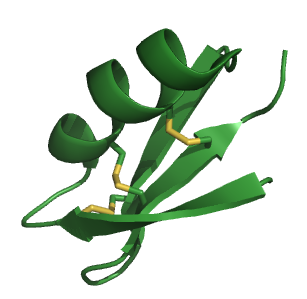Related Research Articles
Endopeptidase or endoproteinase are proteolytic peptidases that break peptide bonds of nonterminal amino acids, in contrast to exopeptidases, which break peptide bonds from end-pieces of terminal amino acids. For this reason, endopeptidases cannot break down peptides into monomers, while exopeptidases can break down proteins into monomers. A particular case of endopeptidase is the oligopeptidase, whose substrates are oligopeptides instead of proteins.
Neurophysin I is a carrier protein with a size of 10 KDa and contains 90 to 97 amino acids. It is a cleavage product of preprooxyphysin. It is a neurohypophysial hormone that is transported in vesicles with oxytocin, the other cleavage product, along axons, from magnocellular neurons of the hypothalamus to the posterior lobe of the pituitary. Although it is stored in neurosecretory granules with oxytocin and released with oxytocin, its biological action is unclear.
omega-Grammotoxin SIA (ω-grammotoxin SIA) is a protein toxin that inhibits P, Q, and N voltage-gated calcium channels (Ca2+ channels) in neurons.

Agitoxin is a toxin found in the venom of the scorpion Leiurus quinquestriatus hebraeus. Other toxins found in this species include charybdotoxin (CTX). CTX is a close homologue of Agitoxin.

Neurophysin II is a carrier protein with a size of 19,687.3 Da and is made up of a dimer of two virtually identical chains of amino acids. Neurophysin II is a cleavage product of the prepro-vasopressin. It is a neurohypophysial hormone that is transported in vesicles with vasopressin, the other cleavage product, along axons, from magnocellular neurons of the hypothalamus to the posterior lobe of the pituitary. Although it is stored in neurosecretory granules with vasopressin and released with vasopressin into the bloodstream, its biological action is unclear. Neurophysin II is also known as a stimulator of prolactin secretion.
Big dynorphin is an endogenous opioid peptide of the dynorphin family that is composed of both dynorphin A and dynorphin B. Big dynorphin has the amino acid sequence: Tyr-Gly-Gly-Phe-Leu-Arg-Arg-Ile-Arg-Pro-Lys-Leu-Lys-Trp-Asp-Asn-Gln-Lys-Arg-Tyr-Gly-Gly-Phe-Leu-Arg-Arg-Gln-Phe-Lys-Val-Val-Thr. It has nociceptive and anxiolytic-like properties, as well as effects on memory in mice.
Taspoglutide is a pharmaceutical drug, a glucagon-like peptide-1 agonist, under investigation for treatment of type 2 diabetes being codeveloped by Ipsen and Roche.
Leumorphin, also known as dynorphin B1–29, is a naturally occurring endogenous opioid peptide. Derived as a proteolytic cleavage product of residues 226-254 of prodynorphin, leumorphin is a nonacosapeptide and has the sequence Tyr-Gly-Gly-Phe-Leu-Arg-Arg-Gln-Phe-Lys-Val-Val-Thr-Arg-Ser-Gln-Glu-Asp-Pro-Asn-Ala-Tyr-Ser-Gly-Glu-Leu-Phe-Asp-Ala. It can be further reduced to dynorphin B and dynorphin B-14 by pitrilysin metallopeptidase 1, an enzyme of the endopeptidase family. Leumorphin behaves as a potent and selective κ-opioid receptor agonist, similarly to other endogenous opioid peptide derivatives of prodynorphin.
Modified GRF (1-29) often abbreviated as mod GRF (1-29), originally known as tetrasubstitued GRF (1-29), is a term used to identify a 29 amino acid peptide analogue of growth-hormone-releasing hormone (GHRH), a releasing hormone of growth hormone (GH). It is a modified version of the shortest fully functional fragment of GHRH, often referred to as growth hormone releasing factor (1-29), and also known by its standardized name, sermorelin.
The yeast mitochondrial code is a genetic code used by the mitochondrial genome of yeasts, notably Saccharomyces cerevisiae, Candida glabrata, Hansenula saturnus, and Kluyveromyces thermotolerans.
Centruroides suffusus suffusus toxin II (CssII) is a scorpion β-toxin from the venom of the scorpion Centruroides suffusus suffusus. CssII primarily affects voltage-gated sodium channels by causing a hyperpolarizing shift of voltage dependence, a reduction in peak transient current, and the occurrence of resurgent currents.
The Blepharisma nuclear code is a genetic code found in the nuclei of Blepharisma.
The trematode mitochondrial code is a genetic code found in the mitochondria of Trematoda.
The scenedesmus obliquus mitochondrial code is a genetic code found in the mitochondria of Scenedesmus obliquus.
The pachysolen tannophilus nuclear code is a genetic code found in the ascomycete fungus Pachysolen tannophilus.
The karyorelictid nuclear code is a genetic code used by the nuclear genome of the Karyorelictea ciliate Parduczia sp.
The Condylostoma nuclear code is a genetic code used by the nuclear genome of the heterotrich ciliate Condylostoma magnum.
The Mesodinium nuclear code is a genetic code used by the nuclear genome of the ciliates Mesodinium and Myrionecta.
The peritrich nuclear code is a genetic code used by the nuclear genome of the peritrich ciliates Vorticella and Opisthonecta.
The Blastocrithidia nuclear code is a genetic code used by the nuclear genome of the trypanosomatid genus Blastocrithidia.
References
- Aagaard et al.: "An inflammatory role for the mammalian carboxypeptidase inhibitor latexin: relationship to cystatins and the tumor suppressor TIG1." Structure13(2), 309–317, 2005.
- Cho et al.: "Hypermethylation of CpG island loci and hypomethylation of LINE-1 and Alu repeats in prostate adenocarcinoma and their relationship to clinicopathological features." J Pathology211(3), 269–277, 2007.
- Gautron et al.: "Ovacalyxin-32, a novel chicken eggshell matrix protein." J Biol Chem276(42), 39243–39252, 2001.
- Jing et al.: "Tazarotene-Induced Gene 1 (TIG1) expression in prostate carcinomas and its relationship to tumorigenicity" J Natl Cancer Institute94(7), 482–490, 2002.
- Liang et al.: "The quantitative trait gene latexin influences the size of the hematopoietic stem cell population in mice." Nature Genetics39(2), 178–188, 2007.
- So et al.: "Multiple tumor suppressor genes are increasingly methylated with age in non-neoplastic gastric epithelia." Cancer Sci97(11), 1155–1158, 2006.